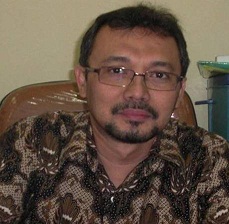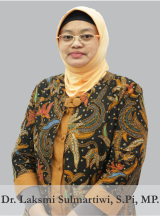Analysis of Chromium (Cr) Heavy Metal Content in Sediments and Mangrove Roots Avicennia marina in the Wonorejo Mangrove Ecosystem Area Surabaya
Downloads
The mangrove area in Wonorejo is quite large and water sources from various areas have the potential to be sources of chromium. One of the mangrove species in this area is Avicennia marina. Avicennia marina plays an important role in reducing pollution. Based on this, a study was conducted to analyze the chromium content in sediment and roots of mangrove A. marina in the Wonorejo area. This study was descriptive with the stages of exploration, observation, and analysis, namely exploring and observing A. marina, taking samples in the field and analyzing samples in the laboratory. The subjects of this study were the roots and sediments of A. marina taken from two stations with three different points by determining the location using purposive random sampling. The chromium levels in the roots and sediments were tested using the Atomic Absorption Spectrophotometer (AAS) method. The data on Cr levels in roots and sediments were analyzed using quantitative descriptive statistics and analyzing the quality of sediments and roots of A. marina in the mangrove ecosystem with safe limit values. The results of this study are: 1) The Cr content in the sediment in the Jagir River was the highest at 1 mg/kg, while in the Afur River the highest was 0.82 mg/kg, 2) The Cr content in the roots of A. marina in the Jagir River is the highest at 2.8 mg/kg, while in the Afur River the highest is 2.5 mg/kg, and 3) The Cr content in the sediment has exceeded the safe threshold of 2.5 mg/kg and the Cr content in the roots has also exceeded the safe threshold of 0.05 mg/kg.
Aminullah, Rachmadiarti, F., & Trimulyono, G. (2015). Isolasi dan karakterisasi rhizobakteri pada akar Rhizopoda mucronata yang terpapar logam berat kromium (Cr). LenteraBio: Berkala Ilmiah Biologi, 4(1):43-49.
Amriani. (2011). Bioakumulasi logam berat kromium (Cr) dan seng (Zn) pada kerang darah (Anadara granosa) dan kerang bakau (Polymesoda bengalensis) di Perairan Teluk Kendari. Tesis. Semarang: Program Pasca Sarjana Universitas Dipenogoro.
Asmadi, A., Endro, S., & Oktiawan, W. (2009). Pengurangan chrom (Cr) dalam limbah cair industri kulit pada proses tannery menggunakan senyawa alkali Ca(OH)2, NaOH, dan NaHCO3
(Studi kasus PT Trimulyo Kencana Mas Semarang). Jurnal Air Indonesia, 5(1):41-54.
Dhokhikah, Y., & Trihadiningrum, Y. (2012). Solid waste management in Asian developing countries: Challenges and oppurtinities. Journal of Applied Environmental and Biological Sciences, 2(7):329- 335.
Dispendukcapil. (2020). Profil perkembangan kependudukan Kota Surabaya 2019. Surabaya: Dinas Kependudukan dan Pencacatan Sipil Kota Surabaya.
Emilia, I., & Suheryanto. (2013). Distribusi logam kadmium dalam air dan sedimen di Sungai Musi Kota Palembang. Jurnal Penelitian Sains, 16(2):59-64.
Hamzah, F., & Setiawan, A. (2010). Accumulation of heavy metal Pb, Cu, and Zn in mangrove in Muara Angke, North Jakarta. Jurnal Ilmu dan Teknologi Kelautan Tropis, 2(2):41-52.
Hastuti, D. (2015). Pengaruh spesifik kelimpahan A. marina terhadap
konsentrasi kadmium (Cd) dalam sedimen di Wilayah Pesisir Demak. Buletin Anatomi dan Fisiologi, 23(1):9-16.
Koller, H. (2013). Waste and climate change the contribution of waste management to reduce greenhouse gas emissions. Journal of Development Management, 1(1):1-2.
Kusriningrum. (2010). Perancangan percobaan. Surabaya: Airlangga University Press.
Maslukah, L. (2013). Hubungan antara konsentrasi logam berat Pb, Cd, Cu, Zn dengan bahan organik dan ukuran butir dalam sedimen di Estuari Banjir Kanal Barat, Semarang. Jurnal Sumberdaya Perairan, 2(3):55-62.
Mukhtasor. (2007). Pencemaran pesisir dan laut. Jakarta: Pradnya Paramita.
Palar, H. (2008). Pencemaran dan toksikologi logam berat. Jakarta: PT. Reneka Cipta.
Poedjirahardjo, E., Marsono, D. & Wardhani, F. K. (2017). Penggunaan principal component analysis dalam distribusi spasial vegetasi mangrove di Pantai Utara Pemalang. Jurnal Ilmu Kehutanan, 11(1):29-42.
Ramos e Silva, C. A., da Silva, A. P., & de Oliveira, S. R. (2006). Concentration, stock and transport rate of heavy metal in a tropical red mangrove. Marine Chemistry, 99(1-4):2-11.
Romimohtarto, K. S. J. (2001). Biologi laut (Ilmu pengetahuan tentang biota laut). Jakarta: Penerbit Jambatan.
Salisbury, F. B., & Ross, C. W. ( 1995). Fisiologi t umbuhan. Jilid III. Bandung: Institut Teknologi Bandung.
Sukoasih, A., & Widiyanto, T. (2017). Hubungan antara suhu, pH, dan
berbagai bariasi jarak dengan kadar timbal (Pb) pada badan air Sungai Rompang dan air Sumur Gali industri batik Sokaraja Tengah Tahun 2016. Buletin Kesehatan Lingkungan Masyarakat, 36(4):360-368.
Sumiono, B., Wasilun, D. & Nugroho. (1991). Evaluasi produktivitas lingkungan perairan laut bagi perencanaan tata ruang perikanan laut di Kalimantan Barat. Jakarta: Prosiding Puslitbangkan.
Suprapti, N. H. (2008). Kandungan chromium pada sedimen dan kerang darah (Anadara granosa) di wilayah pantai sekitar muara Sungai Sayung, Desa Morosari, Kebupaten Demak, Jawa Tengah. Bioma Journal, 10(2):53-56.
Twardy, A. G., Kantor Menteri Negara Lingkungan Hidup Indonesia, Dalhousie University, School for Resource and Environmental Studies, & Environmental Management Development in Indonesia Project. (1995). Soil quality standards for Indonesia. Halifax, N. S.: School of Resource and Environmental Studies, Dalhousie University.
Waykar, B. & Deshmukh, G. (2012). Evaluation of bivalves as bioindicators of metal pollution in freshwater. Bulletin of Environmental Contamination and Toxicology, 88(1):48-53.
Widyasari, N. L., Rai, I. N., Dharma, I. G.
B. S., & Mahendra, M. S. (2023). Analisis kandungan logam berat Pb, Cu, Cd, Cr pada tanaman padi dan jagung yang sistem pengairannya berasal dari Sungai Badung. Ecotrophic Jurnal Ilmu Lingkungan, 17(2):165-173.
Wulan, S. P., Thamrin & Amin, B. (2013). Konsentrasi, distribusi dan korelasi logam berat Pb, Cr dan Zn pada air dan sedimen di Perairan Sungai Siak sekitar dermaga PT. Indah Kiat Pulp and Paper Perawang-Provinsi Riau. Jurnal Kajian Lingkungan, 1(1):72- 92.
Yalcin, M. G., Narin, I., & Soylak, M. (2008). Multivariate analysis of heavy metal contents of sediments from Gumusler Creek, Nigde, Turkey. Environmental Earth Sciences, 54(6):1155-
Copyright (c) 2025 Journal of Marine and Coastal Science

This work is licensed under a Creative Commons Attribution-NonCommercial-ShareAlike 4.0 International License.













